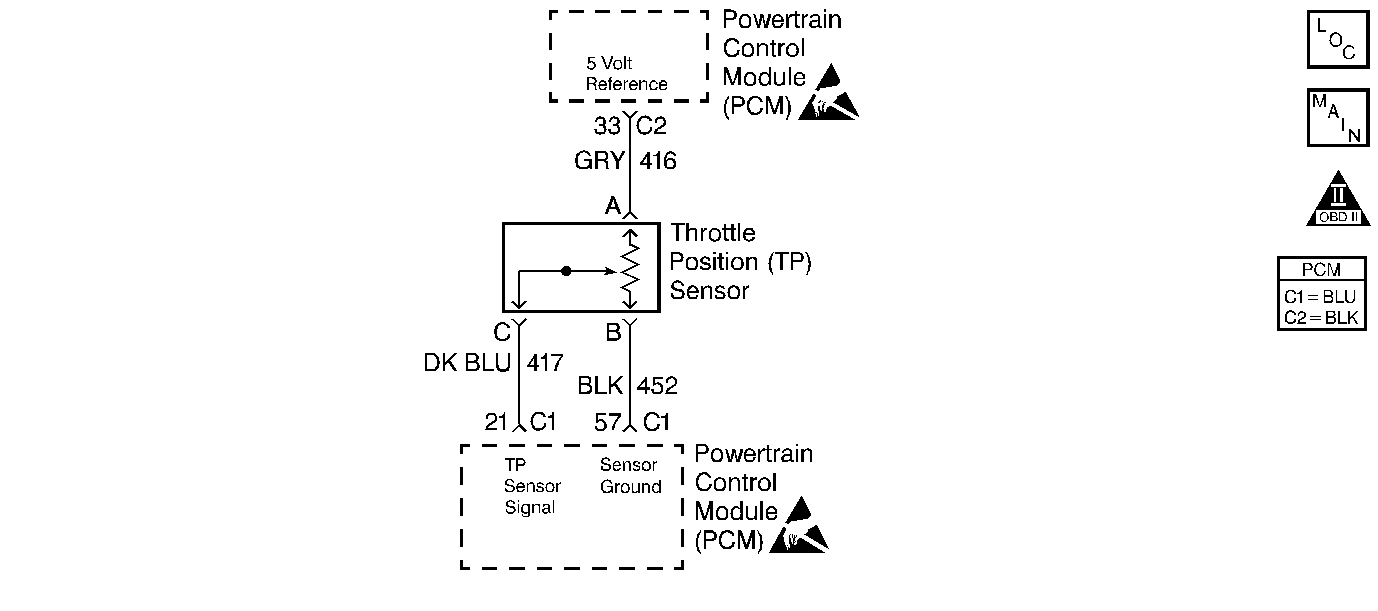
Circuit Description
The Powertrain Control Module (PCM) supplies a 5.0 volt reference signal and a ground to the sensor. The TP sensor sends a voltage signal back to the PCM relative to the throttle plate opening. The voltage will vary from approximately 0.35 volt at closed throttle, to over 4.65 volts at wide open throttle (WOT).
Conditions For Setting The DTC
| • | The TP sensor reads less than 0.20V for 6.25 seconds. |
| • | The engine is running. |
Action Taken When the DTC Sets
| • | The Malfunction Indicator Lamp (MIL) illuminates. |
| • | The PCM records the operating conditions at the time the diagnostic fails. This information will be stored in The Freeze Frame and Failure Records buffers stores this information. |
| • | A history DTC is stored. |
| • | The TP angle will default to 0% when the vehicle speed is less than 2 mph. The TP angle defaults to 10% when the vehicle speed is greater than 2 mph. The scan tool shows the defaulted value. |
Conditions for Clearing the MIL/DTC
| • | The malfunction indicator lamp (MIL) will turn OFF after 3 consecutive ignition cycles in which the diagnostic runs without a fault. |
| • | A history DTC will clear after 40 consecutive warm up cycles without a fault. |
| • | Use a scan tool to clear the DTCs. |
Diagnostic Aids
Whenever this DTC cannot be duplicated, use the information included in the Freeze Frame data in order to evaluate the conditions when the DTC set.
A faulty A/C sensor could set a DTC P0122. Disconnect the A/C electrical connector. If the TP reading returns to normal, replace the A/C Refrigerant Sensor.
Test Description
Number(s) below refer to the step number(s) on the Diagnostic Table.
-
The Powertrain OBD System Check prompts the technician to complete some basic checks and store the freeze frame and failure records data on the scan tool if applicable. This creates an electronic copy of the data taken when the malfunction occurred. The information is then stored in the scan tool for later reference.
-
The TP sensor has an auto zeroing feature. If the voltage reading is between 0.20 V and 0.90 V, the PCM will automatically assume this as closed throttle position (0%).
-
Simulates a DTC P0123. If the PCM recognizes the high voltage signal, then the PCM and wiring are OK.
-
This simulates a high voltage signal which will identify an open in the signal circuit.
-
If additional DTCs are set, check the 5 V reference circuits for a short to ground.
-
If the test light illuminates while probing the TP signal circuit, then the TP signal circuit is shorted to ground.
-
Replacement PCMs must be reprogrammed and the crankshaft position system variation procedure must be performed. Refer to the latest Techline information for PCM reprogramming and also refer to the Crankshaft Position System Variation Learn for the Crankshaft Position System Variation Procedure.
Step | Action | Value(s) | Yes | No |
|---|---|---|---|---|
Was the Powertrain On-Board Diagnostic (OBD) System Check performed? | -- | |||
Is the TP sensor voltage below the specified value? | 0.2V | |||
3 |
Is the TP sensor voltage below the specified value? | 0.2V | ||
Is the TP sensor voltage greater than the specified value? | 4V | |||
Is the TP sensor voltage greater than the specified value? | 4V | |||
|
Important: The Powertrain Control Module (PCM) uses a single 5.0 volt power supply to supply power to all the engine control components. If one component shorts its 5.0 volt reference circuit to ground or battery voltage, the other 5.0 volt reference circuits will also have a low or high voltage. Check the 5V reference circuit for an open or short to ground and repair as necessary. Was a repair necessary? | -- | |||
7 | Check the 5.0V reference circuit for a poor connection at the PCM. Replace the terminal(s) as necessary. Was a repair necessary? | -- | ||
Check the TP sensor signal circuit for open, or a short to ground and repair as necessary. Was a repair necessary? | -- | |||
9 | Check the TP sensor signal circuit for a poor connection at the PCM and repair as necessary. Is the action complete? | -- | ||
10 | Check the connections at the TP sensor. If OK, replace the TP sensor. Refer to Throttle Position Sensor Replacement . Is the action complete? | -- | -- | |
Replace the PCM. Refer to Powertrain Control Module Replacement . Is the action complete? | -- | -- | ||
12 |
Does the scan indicate that this diagnostic ran and passed? | -- | ||
13 | Check if any additional DTCs are set. Are any DTCs displayed that have not been diagnosed? | -- | Go to the Applicable DTC table | System OK |
